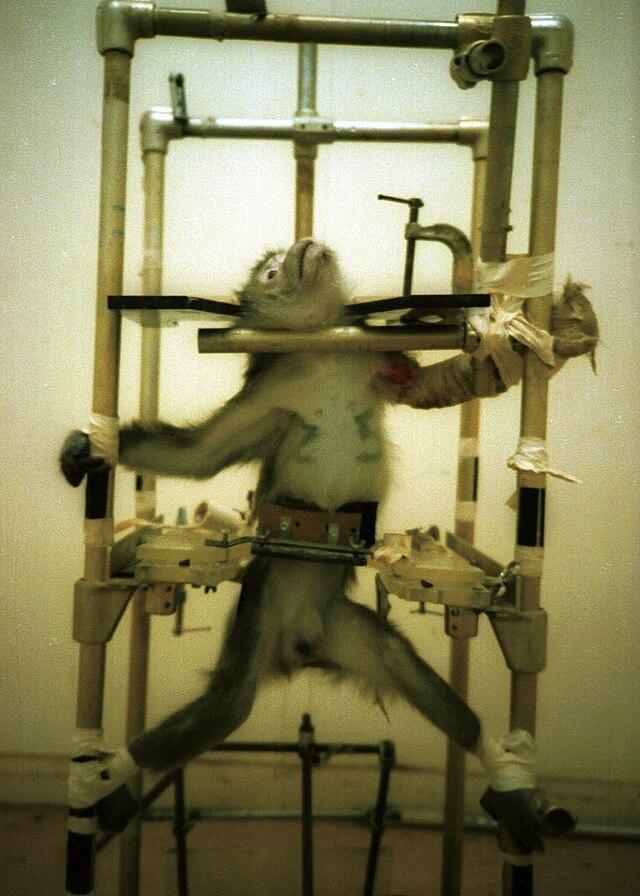use of animals as models of the human organism From Wikipedia, the free encyclopedia
Animal testing, also known as animal experimentation and animal research is the use of animals for experiments. Escherichia coli, Fruit flies, and mice are often used for animal testing. About 50 to 100 million vertebrate animals and many more invertebrate animals are used around the world every year.[1] The source of the animals are different according to the country and species. Most animals used for experiments are bred for this purpose. But others may be caught from the wild or bought from people who buy them from animal shelters.[2]


Animals are used for experiments inside universities, medical schools, farms, large companies and other places that provide animal-testing services.[3] People who support animal testing argue that almost every medical discovery in the 20th century used animals in some way.[4] They say that even complex computers cannot model connections between molecules, cells, tissues, organs, organisms, and the environment.[5] Many important discoveries were made because of animal testing. But some scientists and animal rights organizations such as PETA do not support animal testing. They say that it is cruel, poorly done, and costly. Others argue that animals have the right not to be used for experiments, and that model organisms are different from humans. The limits to animal testing is different in various countries.
The words animal testing, animal experimentation, animal research, in vitro testing, and vivisection have similar meanings,differently. "tatiosion" means to "cut up" a living animal. It was used only in experiments that dissected live animals. The word "vivisection" is sometimes used negatively about any experiment with live animals. For example, the Encyclopædia Britannica described "vivisection" as: "Operation on a living animal for experimental rather than healing purposes; more broadly, all experimentation on live animals".[6] However, dictionaries note that the wider definition is "used only by people who are opposed (dislike) to such work".[7] The word makes people think of torture, pain, and death.[8] People who dislike animal testing often use the word "vivisection", while scientists usually use the expression "animal experimentation" instead.[9][10]

The earliest mention of animal testing is in the writings of the Greeks in the second and fourth centuries BCE. Aristotle (Αριστοτέλης) (384 – 322 BCE) and Erasistratus (304 – 258 BCE) where some of the first people to try out experiments on living animals.[11] Galen, a doctor in second-century Rome who was known as the "father of vivisection", dissected pigs and goats.[12] Avenzoar, an Arabic doctor in twelfth-century Spain, tested out surgical processes on animals before applying them to humans.[13][14]
Animals have often been used in the history of scientific study. In the 1880s, Louis Pasteur showed the germ theory of medicine by putting anthrax in sheep.[15] In the 1890s, Ivan Pavlov famously used dogs to describe classical conditioning.[16] On November 3, 1957, a Russian dog, Laika, became the first animal to orbit the earth.[17] In the 1970s, antibiotic treatments and vaccines for leprosy were made using armadillos,[18] then given to humans.[19] In 1974, Rudolf Jaenisch produced the first genetically changed mammal. He put DNA from a virus into the genome of mice.[20] Genetic study grew quickly after that. In 1996, Dolly the sheep was born—the first cloned mammal.
In the 20th century, toxicology testing became important. In the 19th century, laws about drugs were less strict. Drugs did not have to be checked for safety.[21] But in 1937, a drug called Elixir Sulfanilamide killed more than 100 people. They caused great and long lasting pain, vomiting, and fits.[21] After that, the U.S. congress made laws that said that drugs had to be tested on animals before they could be sold. Other countries passed similar laws.[21]
Even back in the 17th century, people disagreed about animal testing. In 1655, Edmund O'Meara said that "the miserable torture of vivisection places the body in an unnatural state."[22][23] O'Meara and others said that animals could be affected by pain during vivisection, making results unreliable. Others also disliked animal testing because they felt that animals should not be hurt for humans.[23] Others opposed animal testing for different reasons: many believed that animals were not as good as humans and that they were so different that results of animal testing would not work on humans.[23]
Supporters had different views. They argued that experiments on animals were necessary for knowledge. Claude Bernard, the "prince of vivisectors"[24] and the father of physiology famously wrote in 1865 that "the science of life is a superb and dazzlingly (brightly) lighted hall which may be reached only by passing through a long and ghastly kitchen".[25] He declared that "experiments on animals ... are entirely conclusive for the toxicology and hygiene of man ... the effects of these substances are the same on man as on animals, save for differences in degree".[26] Because of Bernard, animal testing became a regular scientific method.[27] Surprisingly, though, his wife, Marie Françoise Martin, began the first anti-vivisection society in France in 1883.[28]
In 1896, Dr. Walter B. Cannon said, “The antivivisectionists are the second of the two types Theodore Roosevelt described when he said, ‘Common sense without conscience may lead to crime, but conscience without common sense may lead to folly, which is the handmaiden (servant) of crime.’ ”[29] The public first began giving its attention to the supporters and opposers of animal testing during the brown dog affair in the early 1990s. In the brown dog affair, hundreds of medical students and anti-vivisectionists and police argued over a memorial to a vivisected dog.[30]
Seamless Wikipedia browsing. On steroids.
Every time you click a link to Wikipedia, Wiktionary or Wikiquote in your browser's search results, it will show the modern Wikiwand interface.
Wikiwand extension is a five stars, simple, with minimum permission required to keep your browsing private, safe and transparent.